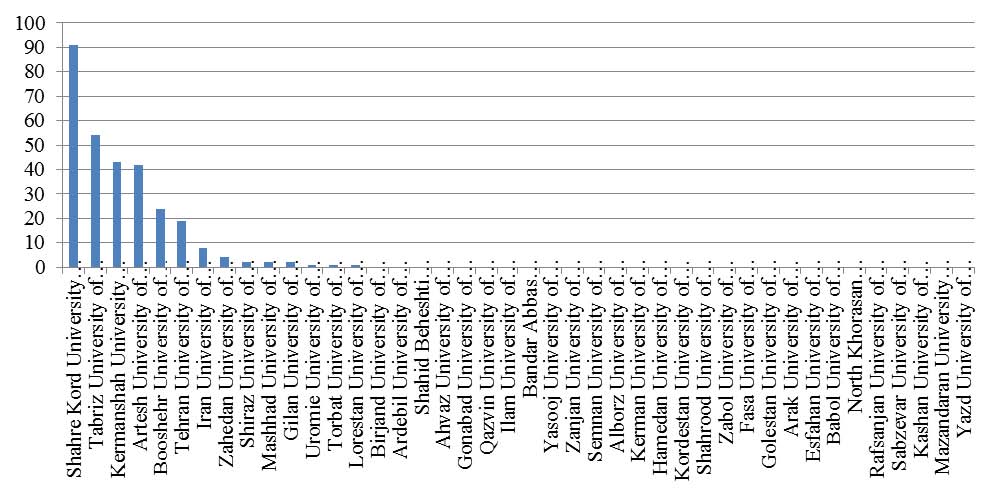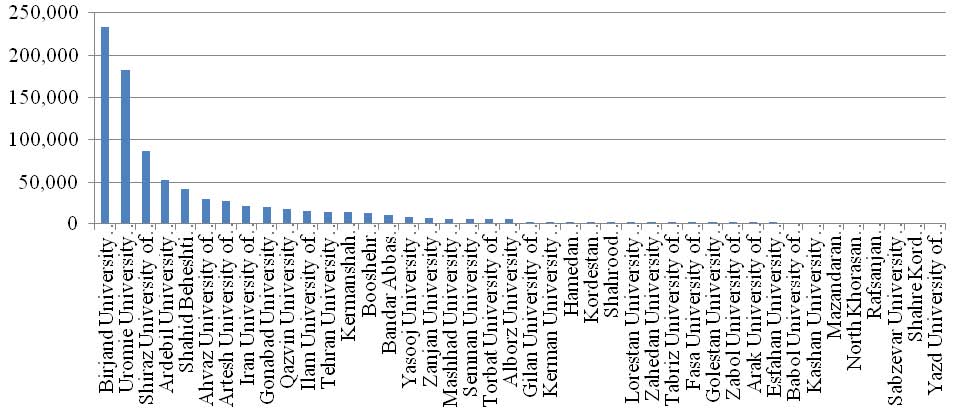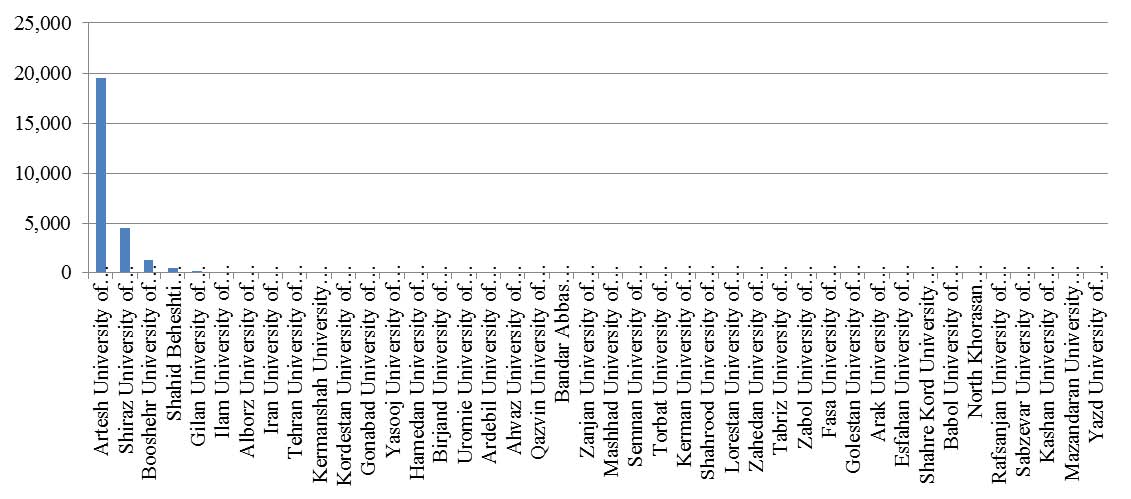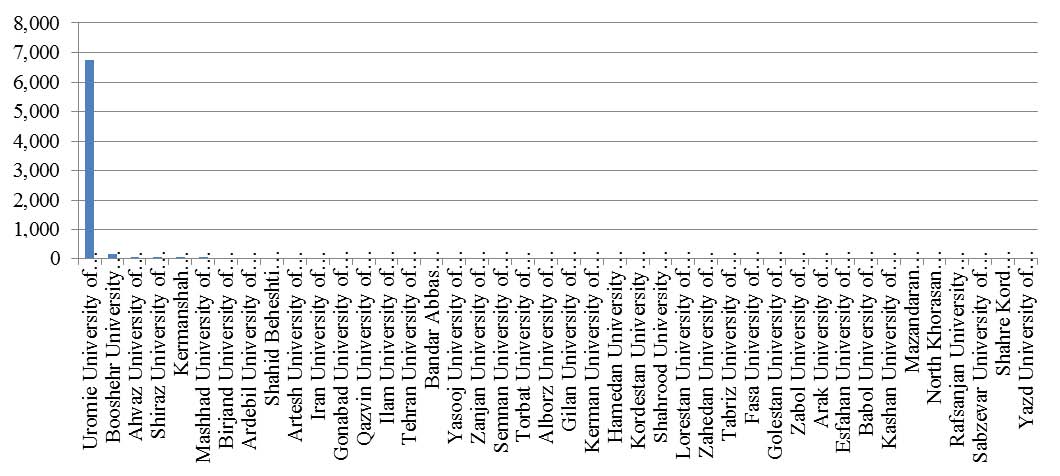
Webometrics Ranking of Digital Libraries of Iranian Universities of Medical Sciences
Abstract
Digital Library websites plays an important role in dissemination of information of the institution and library resources. It acts as a trustworthy mirror of the institute. To evaluate the library website performance webometrics tools and indicators are required. The aim of the present research is study the webometrics of Digital Libraries of Iranian Universities of Medical Sciences on the Web to determine the amount of the visibility a website and web pages. The URL and link of 42 digital library website is obtained directly by visiting the university’s website. To extract the number of indexed web pages (size), rich files have used the Google search engine Also, to extract the number of scientific resources retrieved have used the Google Scholar search engine. To calculate and obtain the number of links received have used the MOZ search engine. Generally, the results indicated that the website of Iranian digital libraries did not have a good performance in term of webometric indexes, and none of them were not rated at all indexes, only some of the websites mentioned in one or two indicators.
Keywords:
Webometrics, Digital Libraries, Website, Visibility, Indexed pages1. Introduction
The past decade has seen an enormous growth in the development of digital libraries, archives and repositories due to the web’s potential to provide easy access to information without geographic constraints. With the introduction of digital information services, there has been an increasing need for information professionals to develop new forms of evaluation (Zuccala et al., 2007). Digital libraries are now typically Web‐based specialty user sites (Thelwall & Zuccala, 2006). Digital libraries include repositories and digital repositories are a new type of library (Armbruster, 2008). Most digital libraries offer the user an interface with searching and/or drilling down options, all aimed at retrieving relevant information quickly and easily (Skibinski & Swacha, 2009). For the purpose of this research, a digital library will simply be defined as: a collection of stored documents, managed by a university, which provides a menu structure for users to freely access these stored documents via an Internet browser. The navigation of websites offers a plethora of opportunities to either assist the user in quickly finding desired materials on websites, or frustrate them to the point of continuing the chase on another website.
Web metrics (‘web metrics’, ‘web analytics’) record and analyze visitor traffic to and through a web site. They can be used to estimate whether or not users’ goals are being achieved; to support usability studies and web design; and to provide feedback on web site use to developers, managers, and other stakeholders. Despite similarities in nomenclature, web metrics are distinct from webometrics (the analysis of the structure and links of the World Wide Web) (Björneborn & Ingwersen, 2004).
Webometrics, the quantitative study of Web‐related phenomena, emerged from the realization that methods originally designed for bibliometric analysis of scientific journal article citation patterns could be applied to the Web, with commercial search engines providing the raw data way to understand the success of e‐commerce web sites by tracking customers and purchases, and because educational and cultural institutions do not use purchasing as a success measure, useful web metrics for digital libraries need to be identified (Khoo et al., 2008). The aim of the present research is study the Webometrics of Digital Libraries of Iranian Universities of Medical Sciences on the Web.
2. Literature Review
Bell (2004, p. 1) draws attention to the growing perception that the rise of open web search engines, such as Google, heralds the demise of libraries. The author uses the term “infobesity” to describe the information search behavior whereby users obtain a “junk‐information diet, consisting of overwhelming amounts of low‐quality material that is hard to digest” from search engines. Bell further argues that people favor open web search engines to library databases because they provide a faster and easier access to “unlimited” web content. The author notes that because library online catalogs and databases are designed to provide precise results for well‐formulated queries, many users find them difficult to use. Bell suggests a two‐pronged solution to the problem: teaching people how to use the databases’ search features, and designing library websites to work as fast as open web search engines.
Shen, Li, and Shen (2006), evaluated 15 websites depended on university libraries, using six indices as library website evaluation criteria: traffic rank, visits, connectivity, speed, pages viewed and freshness. The paper classifies the websites into three groups applying correspondence analysis and gives suggestions for constructing university library websites.
Jowkar and Didegah (2010) evaluated Iranian newspapers’ websites based on the criteria obtained from Alexa databank using correspondence analysis. Results show that most Iranian newspaper websites do not act successfully on the web and need much attention (Jowkar & Didegah, 2010).
Zuccala et al. (2007) used web link analysis and server log files to study the impact and usage of an institutional repository, the National electronic Library for Health, gaining insights into who used the repository, and how they reached it.
Weideman (2010) was carried out a study in titled “Empirical Study on Crawler Visibility of PDF Documents in Digital Libraries.” The aim of his research was to determine to what extent the visibility of these PDF documents can be improved. The results showed that the visibility of PDF files in search engines is very low.
Shukla and Poluru, (2012) analysed the web presence of Indian state universities, and found that open access institutional repositories were helpful in increasing the visibility of institutions on the Web.
Eccles, Thelwall and Meyer (2012) used link data to evaluate several digital resources in the humanities. They collected link data from Yahoo!, and compared target repositories with “comparator” sites, discovering some methodological issues, such as repositories changing their URLs, but also gaining some insights that could inform promotion and marketing of repositories
Onaifo and Rasmussen (2013) investigated an increasing libraries’ content findability on the web with search engine optimization. The aim of their paper is to examine the phenomenon of search engine optimization (SEO) as a mechanism for improving libraries’ digital content findability on the web. The results show that certain websites’ characteristics do have an effect on how well libraries’ websites are ranked by search engines. Notably, the reputation of a library’s website and the number of its search engine indexed webpages increase its ranking on SERPs as well as the findability of its digital content.
Chandra, Nugroho, and Saleh (2014) outlines open access repository in higher education for asean region. This study took as many as 80 universities in the Webometrics ranking of repositories in the Southeast Asia region. The result of this study showed that Institut Teknologi Sepuluh November got the highest score in number of web page in Google (2.010.000), Bogor Agricultural University Scientific Repository got the highest score for number of document paper (44.300). University of Sumatera Utara Repository got the highest score for referring page (82588) and backlink (86421). University Teknologi Malaysia Institutional Repository got the highest score for reffering domain (532).
Blandford (2015) outlines a challenge to public libraries, which have a mandate to facilitate public access to information. A preliminary his study reveals that many public libraries in Canada currently block their catalogues from Google’s indexing robots, effectively rendering their resources invisible to the majority of Internet searchers. Allowing search engines to index library catalogues and employing SEO techniques are strategies that could improve public access to library resources. Additionally, exposing library catalogues to the surface Web is the first step in showcasing the library’s high‐quality resources where the public is looking – on Google. Further SEO could increase collection use, boost program attendance, and facilitate the use of library services; it could also increase the library’s relevance in the eyes of the public.
Orduña and Lopez, 2015, in reviewing the scientific resources of Latin America, showed that indexing of resources in Google and Google Scholar is not enough. The web indices evaluated in this study included the number of pages, the number of rich files, the number of external links, as well as the number of documents stored in the repositories. Storing research outcomes in websites or scientific reservoirs affects webometrics indices. Institutions depended online information systems can independently save researchers’ research output in a more structured way than web pages of groups and research teams, while their help to improve the webometric indices of institutions is more clearly and easier to analyze.
Fan, 2015, in a study entitled “The Contribution of Organizational Scientific Reserves from the Chinese Academy of Sciences”, suggested, based on webometric indices that organizational scientific repositories had a positive effect on the number of Google and Google Scholar pages, the number of rich PDF files, and open access repositories. Therefore, these organizational reservoirs, especially free access repositories, had a considerable impact on the visibility and presence of websites.
Lee et al., 2015, in a case study, surveyed that how much organizational reservoirs could influence the availability and accessibility of the articles on the Web. For this purpose, 170 journal articles with open access were placed in the organizational knowledge reservoir of the State University of Florida. To analyze the impact of organizational knowledge repositories on making the availability of articles to search for title, Google 3 and Google Scholar 4 were addressed, the results were examined. The results showed that from a total of 170 articles, 145 articles were retrieved, with 96 full‐text articles. The results of the positive effect of the reservoir confirmed the availability of information.
Review of previous literature showed that more Webometrics studies has been dedicated to the study of libraries websites and open access repository and it has not been paid attention to other published on university websites. For this purpose, the present study addresses the scientific resources available in the digital libraries. It is being noted that Medical Science University are separate from other universities and college and are under the supervision of the Ministry of Health and Medical Education of Iran. Therefore, Iranian websites of Medical Science University are taken as digital libraries.
3. Methods
The 42 websites of the digital libraries of the Iranian Universities of Medical Sciences were evaluated on 23 February to 28, 2016. The URL and link of each digital library website is obtained directly by visiting the university’s website. To extract the number of indexed web pages (size) have used the Google search engine by the following formula: Site: sitename domain. Also, to extract the number of rich files in the Google search engine have used the formula Site: sitename.domain filetype: pdf, and to extract the number of scientific resources retrieved have used the Google Scholar search engine and formula Site: sitename.domain. To calculate and obtain the number of links received have used the MOZ search engine available at the www.opensiteexplorer.org.
Open Site Explorer is powered by Mozscape, SEOmoz’s index of the links on the internet. Beyond the standard link data, such as linking URLs, linking domains, and anchor text, Mozscape includes unique metrics that provide insight into the authority and trust of pages and domains. The major search engines, Google, Yahoo, and Bing, build similar indexes to help evaluate the importance and relevance of content on the web. Data comes from the World Wide Web itself. Indexing large amounts of data is allowing relevancy research and finds continued activities in competitive community driven for general purpose to web scale search engine (Geetha & Sathiyakumari, 2012). Number of pages recovered from four engines: Google, Yahoo, Live Search and Exalead. The total number of unique external links received (inlinks) by a site can only be confidently obtained from MOZ Engine Search. After evaluation of their relevance to academic and publication activities and considering the volume of the different file formats, the following were selected: Adobe Acrobat (.pdf), Adobe PostScript (.ps), Microsoft Word (.doc) and Microsoft Power point (.ppt). These data were extracted using Google.
Google Scholar provides the number of papers and citations for each academic domain. These results from the Scholar database represent papers, reports and other academic items (http://www. webometrics.info/methodology.html). These four ranks were combined according to a formula where each one has a different weight: The Webometric Analysis can be performed with number of inlinks, outlinks, number of WebPages and number of rich files.
Webometrics Rank (WR) = 4*Rank V + 2*Rank S + 1*Rank R + 1*Rank Sc, Where V = Visibility, S = Size, R = Rich Files and Sc = Google Scholar (Shukla & Poluru, 2012a).
4. Results
Table 1 shows the value of each of the indexes and the final rank of the Webometrics of digital libraries in the medical sciences universities of Iran. Figs. 1‐4 also shows the status of each of the indexes of the Webometrics of digital libraries in the medical sciences universities of Iran. Fig. 1 Shows that the websites of digital libraries of Iranian universities of Medical Sciences of Birjand, Urmie and, Shiraz have the largest number of indexed pages. Fig. 2 Show that the highest visibility indexes or external links are related to Shahre kord, Tabriz and, Kermanshah, respectively. Fig. 3 Shows that the websites of digital libraries of Medical Sciences universities of Artesh, Shiraz and, Boshehr have the highest number of rich files. Fig. 4 Shows that websites of digital libraries of Medical Sciences universities of Urmie has the largest scientific resources indexed in Google Scholar. See more information Table 1 and Figs. 1‐4.

Value of Webometric with the indexes and the final rank in Digital Libraries of Iranian Universities of Medical Sciences

The number of external links visibility of the website of digital libraries of the medical universities of Iran
5. Discussion and Conclusion
Today, one of the major factors to determining success of each university is the amount of visibility of the website and web pages have been affiliated to that university by web searchers. It means that, getting more external links is the most important objective for attaining high ranking due to improve chances for visibility of website’s resources among others. As well as, it can be considered as an indication of the impact of the document and its producer’s (Smith & Thelwall, 2002). Scientific and research repository in the universities, will be made up of rich resources on the web and have a significant impact on the ranking of universities websites. Websites contains digital resources, such as digital library resources, can have been a huge impact on this regard. The results of this study indicate that the digital libraries universities of medical sciences of Birjand, Urmie and Shiraz had the highest percentage of webometrics among other universities. None of the samples were active in all of the indicators and were not ranked in the search engine.
The results of this research also show that Iranian medical universities use native digital library software, they do not use as DSpace, Fedora Greenstone and Eprints to publish their scientific resources in the digital library. Lee‐Hwa, Abrizah, and Noorhidawati (2013) showed that the use of repositories can increase the visibility and availability of scientific resources, followed by the use of resources and the exchange of ideas by researchers.
Previous findings have shown that scientific repositories, open access, scientific researches, collaboration with other universities and online communities on the University’s website increase the visibility of universities on the web (Shukla & Pulro, 2012; Smith, 2012; Fan, 2015; Wing Yang, 2015). Cózar (2015) Orduña and López (2015), also showed that the storing of research outcomes in websites or scientific reservoirs affected on university’s webometric indices. In November 2002, the National Library of Australia (NLA) began exposing its digital collections to search engines using sitemaps. Each item in the library’s digital collections had been given a “persistent identifier” and a “stable web address”, so exposing these resources to search engines simply involved the creation of “a series of web pages, each containing 100 links”, that resolved to the collection items (Boston, 2005).
Generally, the results indicated that the website of Iranian digital libraries did not had a good performance in term of webometrics indexes, and none of them were not rated at all indexes or very low, only some of the websites mentioned in one or two indicators had acceptable criteria. It is recommended that website managers of digital libraries have been familiar with all the indicators of in all indexes, also investigate the high rated indicators to more improve their website. One of the most important reasons for the high visibility of a website is its number of pages, high speed of updating the information, old age of domain, the existence of diverse and useful elements, simple routing, global scope, the existence of electronic journals and full‐text articles. All of the components certainly help to attracting more links (Nowkarizi et al., 2012). Generally, the success of a website depends on factors such as quality, size, language, age of domain, inclusion, and some other factors, only one or two factors cannot be considered as the success a website (Noruzi, 2006). If the number of links to a website increases, its visibility also increases, so more visibility makes to provide better and more relevant coverage for website. Ultimately, coverage and visibility will result to a better ranking of web sites in search engines (Zahedi, Serati Shirazi, & Dehghani, 2010).
References
- Bell, S. J., (2004), The infodiet: how libraries can offer an appetizing alternative to Google, The Chronicle of Higher Education, 50(24), pB15.
-
Björneborn, L., & Ingwersen, P., (2004), Toward a basic framework for webometrics, Journal of the Association for Information Science and Technology, 55(14), p1216-1227.
[https://doi.org/10.1002/asi.20077]

- Blandford, A., (2015), Google, public libraries, and the deep web. Dalhousie, Journal of Interdisciplinary Management, 11.
-
Eccles, K. E., Thelwall, M., & Meyer, E. T., (2012), Measuring the web impact of digitised scholarly resources, Journal of Documentation, 68(4), p512-526.
[https://doi.org/10.1108/00220411211239084]

-
Fan, W., (2015), Contribution of the institutional repositories of the Chinese Academy of Sciences to the webometric indicators of their home institutions, Scientometrics, 105(3), p1889-1909.
[https://doi.org/10.1007/s11192-015-1758-4]

- Geetha, S., & Sathiyakumari, K., (2012), Backlink Analysis Using Mozrank Algorithm of Blogs, International Journal of Computer Science, 1(9).
-
Jowkar, A., & Didegah, F., (2010), Evaluating Iranian newspapers’ web sites using correspondence analysis, Library Hi Tech, 28(1), p119-130.
[https://doi.org/10.1108/07378831011026733]

- Noruzi, A., (2006), Web Presence and Impact Factors for Middle‐Eastern Countries, Online Magazine, 30(2), p22-28.
-
Onaifo, D., & Rasmussen, D., (2013), Increasing libraries’ content findability on the web with search engine optimization, Library Hi Tech, 31(1), p87-108.
[https://doi.org/10.1108/07378831311303958]

- Orduña‐Malea, E., & López‐Cózar, E. D., (2015), The dark side of Open Access in Google and Google Scholar: the case of Latin‐American repositories, Scientometrics, 102(1), p829-846.
-
Shen, X., Li, D., & Shen, C., (2006), Evaluating China’s university library Web sites using correspondence analysis, Journal of the Association for Information Science and Technology, 57(4), p493-500.
[https://doi.org/10.1002/asi.20288]

- Shukla, S. H., & Poluru, L., (2012), Webometric Analysis and Indicators of Selected Indian State Universities, Information Studies, 18(2), p79-104.
- Skibinski, P., & Swacha, J., (2009), The efficient storage of text documents in digital libraries, Information Technology and Libraries, 28(3), p143.
- Smith, A. G., (2012), Webometric evaluation of institutional repositories.
- Smith, A., & Thelwall, M., (2002), Web impact factors for Australasian universities, Scientometrics, 54(3), p363-380.
- Zahedi, Zohreh, Serati Shirazi, Mansooreh, & Dehghani, Leila, (2010), A Webometric Analysis of ISI Medical Journals Using Yahoo, AltaVista, and All the Web Search Engines, Journal of Information processing and Management, 26(1), p89-108.
- Zuccala, Alesia, Thelwall, Mike, Oppenheim, Charles, & Dhiensa, Rajveen, (2007), Web intelligence analyses of digital libraries: A case study of the National electronic Library for Health (NeLH), Journal of Documentation, 63(4), p558-589.
- Armbruster, C., (2008), Access, Usage and Citation Metrics: What Function for Digital Libraries and Repositories in Research Evaluation?.
- Boston, T., (2005), Exposing the deep web to increase access to library collections, Retrieved October, 23, p2006.
- Chandra, R., Nugroho, A. P., & Saleh, F., (2015), Evaluating Open Access Paper Repository In Higher Education For Asean Region, arXiv preprint arXiv:1502.04069.
-
Khoo, M., Pagano, J., Washington, A. L., Recker, M., Palmer, B., & Donahue, R. A., (2008, June), Using web metrics to analyze digital libraries, In Proceedings of the 8th ACM/IEEE‐CS joint conference on Digital libraries, p375-384, ACM.
[https://doi.org/10.1145/1378889.1378956]

- Lee‐Hwa, T., Abrizah, A., & Noorhidawati, A., (2013), Availability and visibility of open access digital repositories in ASEAN countries, Information development, 29(3), p274-285.
- Lee, J., Burnett, G., Vandegrift, M., Baeg, J. H., & Morris, R., (2015), Availability and accessibility in an open access institutional repository: a case study, Information Research: An International Electronic Journal, 20(1), pn1.
- Nowkarizi, M., Soheili, F., Danesh, F., Ryazipoor, M., & Mesrinejad, F., (2012), Webometrics of Iranian universities dominated by the ministry of science, research and technology, Iranian journal of Information Processing & Management, 27(1), p521-536.
- Thelwall, M., & Zuccala, A., (2006, June), LexiURL web link analysis for digital libraries, In Digital Libraries, 2006. JCDL’06. Proceedings of the 6th ACM/IEEE‐CS Joint Conference on, In p371-371, IEEE.
-
Weideman, M., (2010, July), Empirical study on crawler visibility of PDF documents in digital libraries, In Computer Science and Information Technology (ICCSIT), 2010 3rd IEEE International Conference on, 5, p373-379, IEEE.
[https://doi.org/10.1109/iccsit.2010.5563944]

Meisam Dastani currently is PhD student in Knowledge and Information Science, Payame Noor University. He has served as an expert in Information Technology, vice chancellor for research and technology, Gonabad University of Medical Sciences. He is involved in other international and nation projects and her primary research interests include Webometric, Web 2, Semantic web, Data science and Data mining. He wrote 14 research papers. He has also attended 21 conferences and delivered many his papers which are published in the conference proceedings. He actively participated in workshops and held many training workshops. He can be contacted via his e-mail: Meisam.Dastani@gmail.com
Dr. Alireza Atarodi Beimorghi is currently working as an assistant Prof. in Gonabad University of Medical Sciences, teaching English & LIS or IT for medical sciences students from 2000 that is going on now. He was also teaching before in Mashhad Universities. He was central library manager for about 10 years during 2000-2010. He has been teaching and presenting lectures on English & LIS in different Universities and institutions and has been speaker in number of national & international conferences & training workshops. Working with some scientific Journals was another task that he has done and translator of the Journals, too. For some years he published a local Journal in the library he managed it before. He has published about 70 Articles and 3 books up to now.
Somayeh Panahi is MA in Knowledge and Information Science, University of Qom, Qom, Iran. Her main research interests include Scientometrics, Webometric, Ethics of research, Evaluation Writing, and Makerspace in library, and Library and Information Science. She wrote many papers in international and nation (English and Persian). Her vision is to support research advancement in the field of Library and Information Science and publishing best papers in this area. She currently has free time and can be a research colleague. She may be can contact at e-mail: Panahi.s1985@gmail.com


